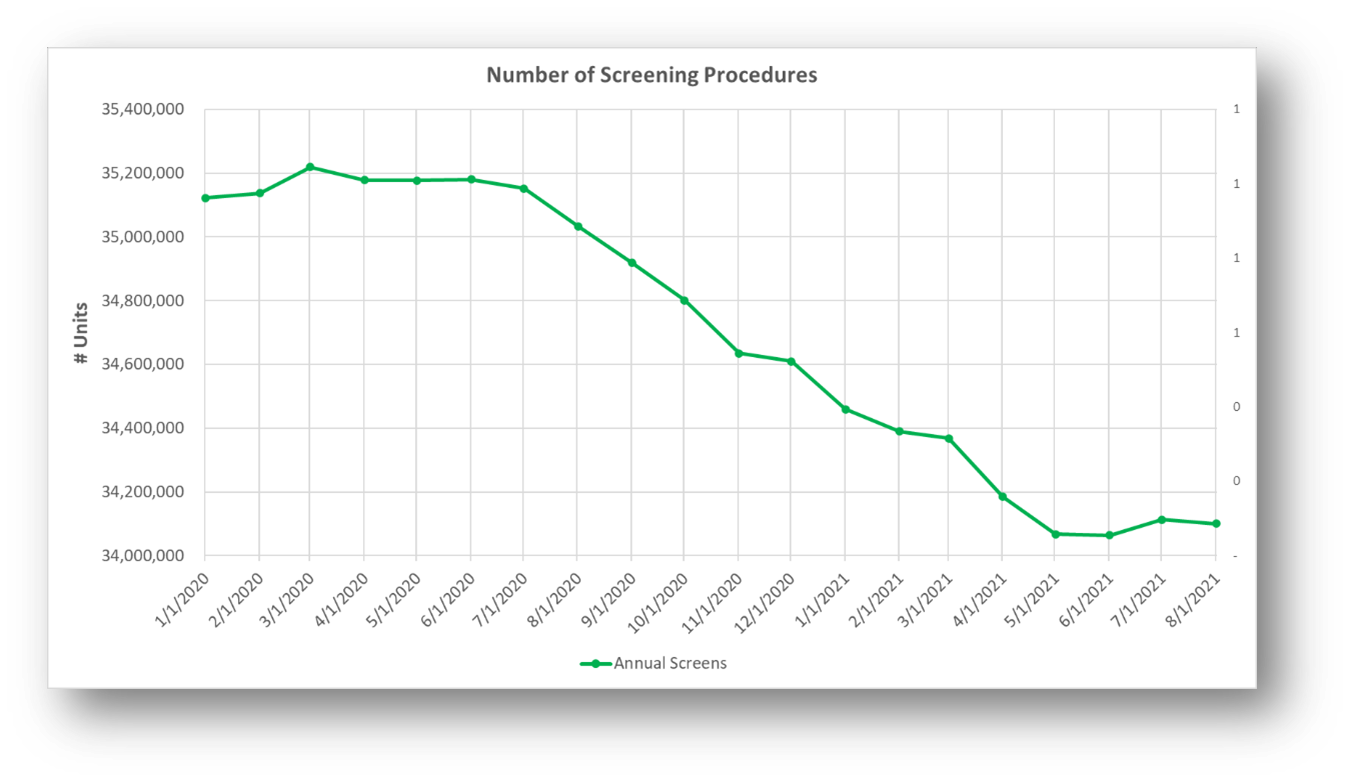Mammography Procedure Volumes in COVID
I think we all realize by now that the pandemic affected everything and changed how we went about our daily lives. The sudden increase in sales of home exercise equipment during the pandemic[i] seems logical, as people felt more and more home-bound and most gyms were closed. The pandemic also caused us to delay those things that, in more normal times, are a routine part of taking care of ourselves—like annual breast screening exams.
Screening mammography took a hit during the pandemic. Patients were naturally cautious, so breast imaging facilities had to react to that caution by following guidelines and developing safe means by which they could continue screening. Then they had to get patients to come back.
The chart below shows that US screening mammography procedure volume declined from June 2020 to May 2021. The data is derived from the US FDA MQSA statistics[ii], adjusted for screening procedures only according to Lehman 2017[iii].

The running commentary in the press at the was a bit gloomy. Just look at the headlines:
· Pandemic paralysis: COVID-19 has major impact on imaging (Aunt Minnie, Apr 30, 2020)
· Disruptions in preventive care: Mammograms during the COVID-19 pandemic (Health Services Research, Nov 4, 2020)
· Is COVID-19 making breast radiologists work harder? (Aunt Minnie, Apr 14, 2020)
· COVID-19 casts long shadow on women’s imaging (Aunt Minnie, Nov 16, 2020)
· The Backlog in Mammograms During the COVID-19 Pandemic (Health Policy$ense, Dec 21, 2020)
· Is It Safe to Get a Mammogram During the Pandemic? (HealthEssentials, Feb 18, 2021)
The Aunt Minnie article from November 2020 cited a survey performed by IMV Medical Information (a sister company of Aunt Minnie) stating that X-ray mammography units experienced a 70.4% decline in procedure volume “early in the year”. Similarly, an article by Sprague et al[iv] stated that screening volumes were only 1.1% of normal in April 2020 but rebounded to 89.7% of normal by July 2020.
So, why is that precipitous drop not evident in monthly reported data from MQSA plotted above? The answer lies in what was happening within the MQSA inspection team during that time. As evidence, consider the number of facility inspections reported per month (below). The statistics show that no inspections were done in April or May of 2020 (reported on the first day of the subsequent month) and that fewer than 200 were done in June.

It is the annualized nature of the way MQSA reports mammography volume data that masks the true and immediate effect of the pandemic.
Nonetheless, there is no mistaking that volumes were reduced during the pandemic by no less than 1.1 million screens per annum, a reduction of 3.16%. The overall impact does show up in subsequent months. But, because of the rolling averages being reported, the short-term drop in procedure volumes reported by Sprague is masked.
The fact that the MQSA data does not show huge swings means that breast imaging centers found a way to recover. To get there, they did a remarkable job of creating and adopting pandemic-safe procedures and making up for lost time. Kudos to their leaders!
[i] https://www.washingtonpost.com/road-to-recovery/2021/01/07/home-fitness-boom/
[ii] MQSA Statistics, accessed at: https://www.fda.gov/radiation-emitting-products/mqsa-insights/mqsa-national-statistics
[iii] Lehman CD, Arao RF, Sprague BL, et al. National Performance Benchmarks for Modern Screening Digital Mammography: Update from the Breast Cancer Surveillance Consortium. Radiology. 2017;283(1):49-58. doi:10.1148/radiol.2016161174
[iv] Sprague BL, Lowry KP, Miglioretti DL, Alsheik N, Bowles EJA, Tosteson ANA, Rauscher G, Herschorn SD, Lee JM, Trentham-Dietz A, Weaver DL, Stout NK, Kerlikowske K. Changes in Mammography Utilization by Women’s Characteristics during the First 5 Months of the COVID-19 Pandemic. J Natl Cancer Inst. 2021 Mar 29:djab045. doi: 10.1093/jnci/djab045. Epub ahead of print. PMID: 33778894; PMCID: PMC8083761.